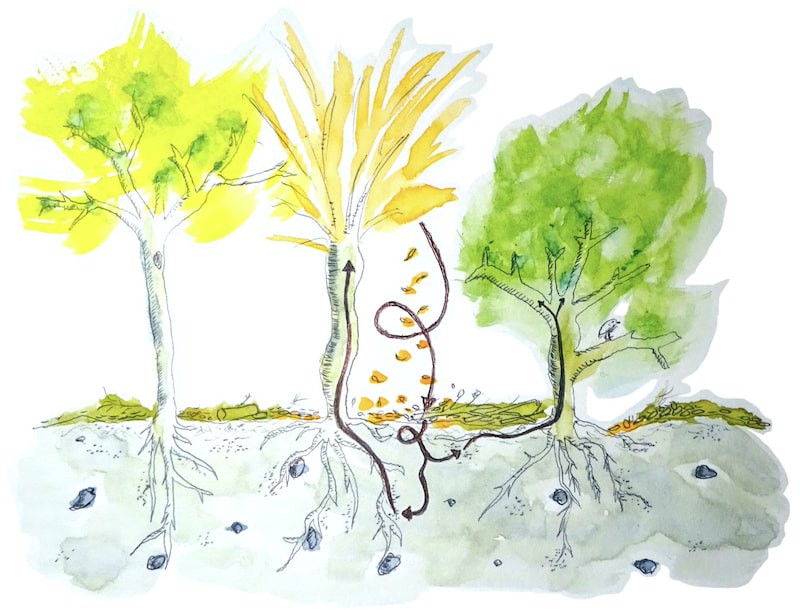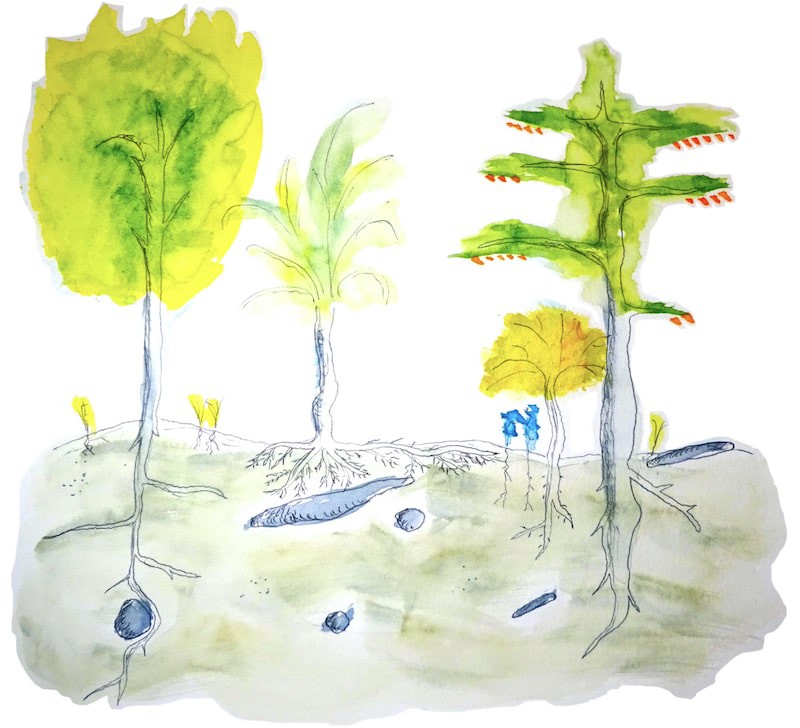Four key principles of natural forests that we can mimic on our balcony

I originally published this article in French on the webzine Vibre Magazine. It is the 1st episode of a series of 4 articles on planting a tiny food forest on the balcony.
A food forest, or forest garden, is a forest where trees and plants produce leaves, roots, fruits, and nuts that can be eaten. In fact, such a forest garden mimics what works so well in natural forests, but with the plant species adapted so that you can “eat the forest”.
For the gardener, the main benefit is that by planting perennial plants only once, such as trees, you get lots of harvests over decades.
Gardening a forest is a very old practice, done for example in the Amazon forest or among the Pygmies in Africa. Recently, in the second half of the XXᵉ century, some pioneer market gardeners like Robert Hart in England, tried to develop garden forests in temperate climates. Since then, this practice has become more widespread, especially on permaculture farms.
In general, an edible forest is set up in a large garden, or on a farm, aiming at achieving some degree of food self-sufficiency. But, here, I propose to mimic the forest on a tiny scale, on your balcony!
At this scale, it is already possible to observe the major ecological principles, produce some organic food, and learn a lot about nature.
Table of Content
1. The carbon cycle: the key to fertility
In a natural forest, dead branches fall on the wet ground. This is an ideal food for fungi! In the form of white filaments called mycelium, they colonize and digest this carbon-rich plant material, forming humus.
Humus can store minerals and water. A soil rich in carbon, rich in humus, is, therefore, an ideal soil for plant growth, because it is a stock of nutrients and water.
But that’s not all!
These mushroom filaments are themselves the food of a host of tiny insects and worms. These insects and worms also contribute to the development of rich, moist soil by aerating it and offering their droppings.
A regular supply of dead plant material on moist soil. These are two elements found in the forest, and which are essential to maintain a lively ecosystem.

2. Light: the source of energy
In a natural forest, the trees are close to each other, the big trees above the smaller ones, themselves above the bushes. Often, very few sunrays reach the ground!
The sun is the only source of energy for the plants, and the forest gradually fills each space, until it receives all the available energy. The more the forest is organized in strata, the more light it captures, and the more plant matter it produces, fruits, leaves, etc.
Moreover, this dense shade keeps the soil moist. Fungi develop and recycle plant matter. The more light the forest captures, the fresher the soil, the more its fertility is reproduced by the life of the soil microorganisms!
A dense canopy. This allows the forest to capture as much energy as possible, and to keep the soil cool.

3. Diversity: the key to resilience
In a natural forest, many species of plants live together.
Each species has a different shape. Each species uses different resources. Some species have deep roots, others shallow roots. Some species attract pollinating insects, others repel greedy insects.
This biological diversity, this biodiversity, allows optimal use of soil, water, and light resources. It also makes the forest more resilient, because if a disease spreads, it will only affect one species of tree and will be blocked by other species.
A great diversity. This allows the forest to function optimally and resiliently.

4. Natural disturbances: a perpetual rejuvenation
In a natural forest, many disturbances occur naturally.
A storm knocks down trees, which suddenly become food for mushrooms. A fire opens up a clearing, where the sun hits and dries out the soil. A family of beavers chops down trees. A herd of wild boars turns the soil over.
More than a perfectly balanced place, a forest is a scene of continuous cycles and changes. Each disturbance redraws the contours, rearranges the strata, re-diversifies the species.
Continuous disturbances. This is an element that constantly revitalizes the forest ecosystem.

And now, how can we reproduce these 4 mechanisms on our little balcony?
On our balcony, let’s mimic the forest!
Let’s try to reproduce these phenomena on a small scale: a dynamic carbon cycle, dense and stratified vegetation, plant diversity, and disturbances from time to time.
A design proposal
I think that a mini balcony forest should look like the gardener who takes care of it. So I’m not giving a recipe here to be applied in all cases, but rather an example of design, to be reinvented in each case.
For example, let’s use a container filled with potting soil, 20 cm wide, 60 cm long, and 30 cm high. Any soil can be used, but when starting, it is easier to buy rich soil or to get good soil from someone else, to limit failures at the beginning!
In this bin, let’s plant some perennial vegetables: a perpetual leek, a sweet potato, hardy ginger, and kale. And let’s add two easy-to-grow annuals: a cherry tomato plant, and a basil plant.

If you already make your compost, then you can add it regularly to your bin, to feed the carbon cycle. If you don’t have one, I suggest you get straight to the point: just as branches fall directly to the ground in the forest, why not try simply spreading your food waste on the surface of the bin? They will decompose little by little.
Step by step, the plants will grow, become denser, shade the ground, and probably spread out a bit around. A real mini-forest!

Now let’s look at how this very simple design actually reproduces the general functioning of the forest.
- Carbon cycle
By regularly adding food waste, or compost, we constantly stimulate the carbon cycle. This contribution keeps the soil moist, enriches it with minerals, and feeds fungi, micro-insects, and worms.
A constant supply of matter on wet soil. Perfect!
- Light
Kale and sweet potato capture a lot of the sun’s rays, including around the planter. But the cherry tomato plant is not to be forgotten! Climbing around a stake, it catches the light very high. While lower down, the basil and the perpetual leek recover the rays that haven’t been captured yet.
All the light is captured, and the ground is shaded. Ideal!
- Diversity
Our little planter contains six plants. Each of them belongs to a different botanical family. Sweet potatoes, ginger, and perpetual leek take over the soil with their roots and rhizomes. The tomato plant and kale occupy the air space! Each plant uses resources differently. If an insect settles on one plant, the others will not be affected. Some even help each other: protected from the sun by the tomato plant, the basil protects the tomato from mildew.
Botanical diversity, diversity of form, better resilience. Magnificent!
- Perturbations
When the kale leaves take over the whole space, we eat them. When the sweet potatoes or ginger are ready, we uproot them, replant one piece, and eat the others. When the tomato plant stops producing in late fall, it is pruned and the dead stems are spread on the surface of the planter.
The herbivorous gardener continuously revives the dynamics of the ecosystem. Great!
The 6 plants I suggest
- Hardy ginger (e.g. Zingiber mioga) - Zingiberaceae, perennial
- Perennial leek - Amaryllidaceae, perennial
- Kale (e.g. Palmetto ‘Black Tuscan’) - Brassica, biennial
- Sweet potato - Convolvulaceae, grown as an annual in a temperate climate, but the root can be replanted
- Basil - Lamiaceae, perennial in warm climates, grown as an annual in temperate climates, and the seeds are easy to collect and sow
- Cherry tomato (e.g. ‘Indigo Blue Berry’ tomato) - Solanaceae, annual, but seeds are easy to collect and sow
Let me know about your experiments to mimic the forest on your balcony!
Did you like this article?
Great! Then, you may also like to read the next episode of this series, to know where to find those perennial vegetables and how to plant them.